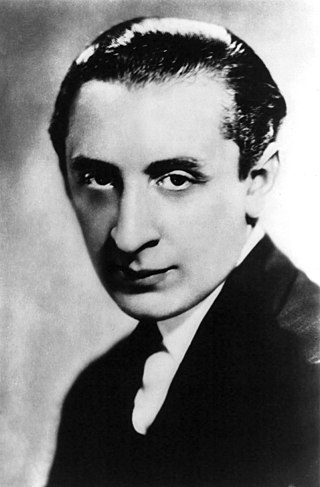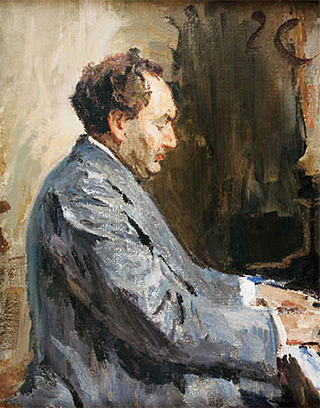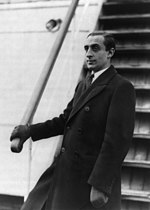
Vladimir Samoylovich Horowitz was a Russian-American classical pianist. Considered one of the greatest pianists of all time, he was known for his virtuoso technique, timbre, and the public excitement engendered by his playing.

Sergei Rachmaninoff's Piano Concerto No. 3 in D minor, Op. 30, was composed in the summer of 1909. The piece was premiered on November 28 of that year in New York City with the composer as soloist, accompanied by the New York Symphony Society under Walter Damrosch. The work has the reputation of being one of the most technically challenging piano concertos in the standard classical piano repertoire.

Felix Mendelssohn's Violin Concerto in E minor, Op. 64, MWV O 14, is his last concerto. Well received at its premiere, it has remained among the most prominent and highly-regarded violin concertos. It holds a central place in the violin repertoire and has developed a reputation as an essential concerto for all aspiring concert violinists to master, and usually one of the first Romantic era concertos they learn. A typical performance lasts just under half an hour.

The Piano Concerto No. 1 in B♭ minor, Op. 23, was composed by Pyotr Ilyich Tchaikovsky between November 1874 and February 1875. It was revised in 1879 and in 1888. It was first performed on October 25, 1875, in Boston by Hans von Bülow after Tchaikovsky's desired pianist, Nikolai Rubinstein, criticised the piece. Rubinstein later withdrew his criticism and became a fervent champion of the work. It is one of the most popular of Tchaikovsky's compositions and among the best known of all piano concerti.
Réminiscences de Don Juan is an opera fantasy for piano by Franz Liszt on themes from Mozart's 1787 opera Don Giovanni.
Sergei Rachmaninoff's Prelude in C-sharp minor, Op. 3, No. 2, is one of the composer's most famous compositions. Part of a set of five piano pieces titled Morceaux de fantaisie, it is a 62-bar prelude in ternary (ABA) form. It is also known as The Bells of Moscow since the introduction seems to reproduce the Kremlin's most solemn carillon chimes.

The Fantasy on Themes from Mozart's Figaro and Don Giovanni, S.697, is an operatic paraphrase for solo piano by Franz Liszt, based on themes from two different Mozart's operas: The Marriage of Figaro, K.492 and Don Giovanni, K.527.
Three Concert Études, S.144, is a set of three piano études by Franz Liszt, composed between 1845–49 and published in Paris as Trois caprices poétiques with the three individual titles as they are known today.

John Maver is an Australian pianist and composer.
Cinque variazioni is a composition for solo piano by Luciano Berio, written in 1952–53 and greatly revised in 1966. It was published by Suvini Zerboni and the first performance was given by Berio in Milan in 1953. The variations are based on a three-note melodic cell—"fratello"[014]—from the opera Il prigioniero by Luigi Dallapiccola, to whom the work is dedicated. Major changes between the two versions are indicated below, but many other small changes may be found, mostly additions to render the harmony more complex.

Hungarian Rhapsody No. 2 in C-sharp minor, S.244/2, is the second in a set of 19 Hungarian Rhapsodies by composer Franz Liszt, and is by far the most famous of the set.
Piano Sonata No. 2, Op. 36, is a piano sonata in B-flat minor composed by Sergei Rachmaninoff in 1913, who revised it in 1931, with the note, "The new version, revised and reduced by author."

The Nocturnes, Op. 55 are a set of two nocturnes for solo piano written by Frédéric Chopin. They are his fifteenth and sixteenth installations in the genre, and were composed between 1842 and 1844, and published in August 1844. Chopin dedicated them to his pupil and admirer Mademoiselle Jane Stirling.

Au bord d'une source is a piano piece by Franz Liszt; it is the 4th piece of the first suite of Années de Pèlerinage.

Étincelles, Op. 36 No. 6(Sparks) is a piece for solo piano by Moritz Moszkowski. It is the sixth piece from Moszkowski's 8 Characteristic Pieces set.

Passacaglia is a solo piano composition by the composer Leopold Godowsky. It was completed in New York, on October 21, 1927. The composition commemorates the one hundredth anniversary of the death of Franz Schubert. Typical of Godowsky's composition style, the piece contains dense contrapuntal, polyphonic, and chromatic writing.

The Russian-American classical virtuoso pianist Vladimir Horowitz was a recording artist for over 60 years; beginning in 1926 on a piano roll system for Welte-Mignon, then with audio recordings, starting in 1928 for the Victor Talking Machine Company, later RCA Victor. Horowitz continued to record for a variety of record labels throughout his life. Between 1962 and 1973 he recorded for Columbia Masterworks In 1975, Horowitz returned to RCA, with which he recorded a series of live recitals. For the last years of his life, between 1985 and 1989, Horowitz recorded for Deutsche Grammophon. Horowitz's final recording, with Sony Classical, was completed in November 1989, four days before his death. This final recording consisted of repertoire that he had never previously recorded. His discography contains numerous albums and compilations of works by a variety of composers. Horowitz has also appeared in several video items, most of these were produced in the later years of his life.
The Piano Sonata in E-flat minor, Op. 26 was written by Samuel Barber in 1949 for the twenty-fifth anniversary of the League of Composers. Commissioned by Irving Berlin and Richard Rodgers, it was first performed by Vladimir Horowitz and has remained a popular concert staple since.
The Variations on a Rococo Theme, Op. 33, for cello and orchestra was the closest Pyotr Ilyich Tchaikovsky ever came to writing a full concerto for cello and orchestra. The style was inspired by Mozart, Tchaikovsky's role model, and makes it clear that Tchaikovsky admired the Classical style very much. However, the Theme is not Rococo in origin, but actually an original theme in the Rococo style.

Les pêcheurs de perles is an opera in three acts by the French composer Georges Bizet, to a libretto by Eugène Cormon and Michel Carré. It was premiered on 30 September 1863 at the Théâtre Lyrique in Paris, and was given 18 performances in its initial run. Set in ancient times on the island of Ceylon, the opera tells the story of how two men's vow of eternal friendship is threatened by their love for the same woman, whose own dilemma is the conflict between secular love and her sacred oath as a priestess. The friendship duet "Au fond du temple saint", generally known as "The Pearl Fishers Duet", is one of the best-known in Western opera.

















